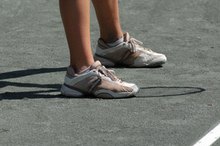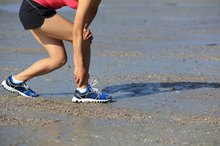Running & Collarbone Pain
Your collarbone is also known as a clavicle 3. Pain in your collarbone while you run is a sign of damage to the bone. This damage could be a simple bruising of the bone, or it could be a fracture or dislocation. In many cases it is a combination of two or more of these conditions.
If you are experiencing serious medical symptoms, seek emergency treatment immediately.
Causes
Damage to the collarbone usually occurs as a result of trauma. In most cases, it is blunt force trauma. Collarbone injuries are common in athletes. Brittle bones due to lack of calcium may also contribute to the occurrence of this injury. In some cases collarbone injuries are caused by awkward movements that dislocate the bone.
- Damage to the collarbone usually occurs as a result of trauma.
Symptoms
Causes of Burning Calf Pain
Learn More
Pain and swelling are the most common symptoms of collarbone damage. The swelling and pain are located in the vicinity of the collar bone. Moving your arm may also cause pain when you have collar bone damage. Impact waves caused by running may also cause pain in a damaged collar bone.
- Pain and swelling are the most common symptoms of collarbone damage.
- Moving your arm may also cause pain when you have collar bone damage.
Diagnosis and Treatment
Diagnosis of a collarbone injury is done by a physician. A diagnosis is made through a physical examination and X-ray examination. The treatment regimen of a collar bone injury can include immobilization, pain killing medication -- generally with anti-inflammatory medication -- and, in rare instances, surgery.
Alternatives Exercise to Running
Torn Tendons & Ligaments From Hyperextension
Learn More
Running is a high impact exercise that sends shock waves through your body every time your feet slam into the ground. Substitute running with low impact exercises such as stationary biking and elliptical training. These exercises will provide the same aerobic workout without aggravating your collarbone injury.
Related Articles
References
- "Exercise and Health"; Prof. T. A. Asmangulyan
- "Guyton and Hall Textbook of Medical Physiology"
- University of Michigan Health System: Broken Collarbone (Clavicle)
- Söyüncü S, Bektaş F, Cete Y. Traditional Kehr's sign: Left shoulder pain related to splenic abscess. Ulus Travma Acil Cerrahi Derg. 2012;18(1):87-8. doi:10.5505/tjtes.2011.04874
- Villa-Forte A. Musculoskeletal Pain. Merck Manual Consumer Version. 2019.
- Clavicle Fracture (Broken Collarbone). American Academy of Orthopaedic Surgeons.
- Shoulder Trauma (Fractures and Dislocations). American Academy of Orthopaedic Surgeons.
- Rotator cuff problems. US National Library of Medicine. 2019.
- Thoracic Outlet Syndrome. Johns Hopkins Medicine.
- Andreacchio A, Marengo L, Canavese F. Condensing osteitis of the clavicle in children. World J Orthop. 2016;7(8):494-500. doi:10.5312/wjo.v7.i8.494
- Anyfantakis D, Kastanakis M, Karona P, Fragiadakis G, Kokkinos I, Bobolakis E. Spontaneous rupture of the spleen masquerading as a pulmonary infection. Case Rep Surg. 2014.
- Broken Collarbone (Clavicle Fracture). TeensHealth from Nemours. 2018.
- Magnetic Resonance Imaging (MRI) - Musculoskeletal. Radiological Society of North America. 2019.
- Lee KJ, Jung K, Kim J, Kwon J. Bone scan as a screening test for missed fractures in severely injured patients. Orthop Traumatol Surg Res. 2014;100(8):953-957.
- Infections After Fracture. American Academy of Orthopaedic Surgeons.
- Andreacchio A, Marengo L, Canavese F. Condensing osteitis of the clavicle in children. World Journal of Orthopedics. 2016;7(8):494-500. DOI: 10.5312/wjo.v7.i8.494.
- Ashley A. Weaver, Jennifer W. Talton, Ryan T. Barnard, Samantha L. Schoell, Katrina R. Swett & Joel D. Stitzel(2015). Estimated Injury Risk for Specific Injuries and Body Regions in Frontal Motor Vehicle Crashes, Traffic Injury Prevention. 16:sup1, S108-S116. DOI: 10.1080/15389588.2015.1012664.
- Freischlag J, Orion K. Understanding Thoracic Outlet Syndrome. Scientifica. 2014;2014:248163. DOI: 10.1155/2014/248163.
- Murphy RJ, Carr AJ. Shoulder pain. BMJ Clinical Evidence. 2010;2010:1107.
- SACCOMANNO MF, DE IESO C, MILANO G. Acromioclavicular joint instability: anatomy, biomechanics and evaluation. Joints. 2014;2(2):87-92.
- Sergent SR, Johnson SM, Ashurst J, Johnston G. Epstein-Barr Virus-Associated Atraumatic Spleen Laceration Presenting with Neck and Shoulder Pain. The American Journal of Case Reports. 2015;16:774-777. DOI: 10.12659/AJCR.893919.
Writer Bio
Dr. Robert Petros has been working at the Yerevan State Medical University Department of Epidemiology and Infectious Diseases since 2009. He has had experience with thousands of patients and done a considerable amount of work in epidemic prevention on the government level.









